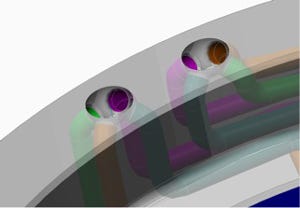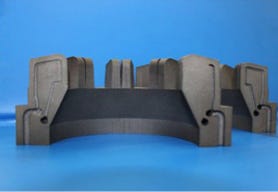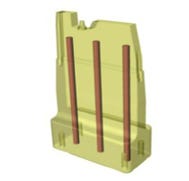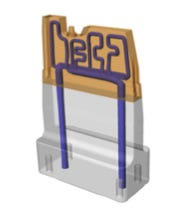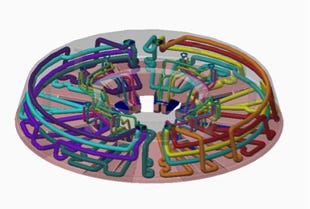The process of designing a mold tool involves a series of compromises between sometimes conflicting requirements. These include:
June 25, 2015
meeting the customer's part quality expectations, such as flatness, surface finish and an absence of warpage, sinks and blemishes;
splitting the designed part geometry in a way that results in robust tool cavity parts that are readily manufacturable;
filling the cavity with plastic and incorporating runner, gate and venting design
cooling the tool without hot or cold spots, and without compromising part quality while maximizing the production rate;
ejecting the plastic part evenly without damage.
These five basic design requirements have to fit around the part design in the same space. If one requirement has more flexibility, it leaves greater options in the other areas. For example, the use of spark erosion to create square recesses means that a tool does not have to be split into as many pieces as would be needed if only conventional machining techniques were used.
|
The cooling channels are indicated in color. |
Conformal cooling is an analysis to establish the most effective uniform cooling of the injection molded parts. This generally results in a more complex cooling channel arrangement than can be achieved by conventional machining. Additive manufacturing techniques allow the cooling channels to be made exactly as the analysis demands, without the limitations that normal machining techniques have in following complex cavity geometry. This results in quicker, more-even cooling of the plastic and, hence, cheaper, more-accurate products.
Conformal cooling is made possible by using an additive manufacturing process, where metal powder is melted by focused laser beams, layer upon layer. These layers are built up and joined together as a solid block via direct metal laser sintering (DMLS). The layer thickness can vary down to 0.02 mm, depending on the finish required, balanced against the time and cost of manufacture. A solid metal part is produced without limitations in its internal or external geometry. This allows cooling channels of any shape of to be built into the part (following the cavity shape). The external geometry can be machined and polished to ensure the molding surface has a smooth finish.
Conformal cooling offers much greater flexibility in the design of cooling for the mold. With the correct computer flow and cooling analysis of the part, it is possible for mold cooling to be optimized in a way that is not possible using conventional drilling, plugs, bubblers and baffles. This can shorten what is often the longest part of mold cycle time—setup—and simultaneously improve part quality, especially in the common problem areas of distortion and warping.
Cooling channels can be made in any shape so diameters can vary; baffles can be built in to introduce turbulence and, hence, a cooling effect; and cross sections can be oval or square. The accuracy of cooling channels is not compromised by long drilling lengths that are prone to wandering, so the cooling channels function as they were designed to do.
|
Cooling channels are visible in a laser-sintered |
In addition, conformal cooling can leave more space for the other requirements listed above, which can lead to better optimization of the tool in these areas. For instance, a gate position that would be ideal to fill the part but impossible to accommodate with conventional cooling channels may be possible with a laser-sintered insert. Therefore, to maximize the benefits of conformal cooling, the whole tool design needs to be integrated around it.
No need to compromise tool life
Now that conformal cooled inserts can be built from fully heat-treatable H13 tool steel, there is no need to compromise tool life to experience the benefits. This steel option also allows conformal cooling to be applied to pressure die cast tooling. Zinc die casting would be an ideal application, as the amount of cooling in the tool is often the limiting factor in the achievable production rate. Blowmolding is another process that could be improved by the application of conformal cooling.
While laser sintering has been used for decades, there is still a learning curve to its best use in conformal cooling applications. Guidance is needed for where and how to use the technique to ensure a positive cost/benefit ratio.
One area where a company with expertise in the design and manufacture of conformal cooled mold tools can help is in mixing the metal-building process (laser sintering) and the metal-removal process (machining) to achieve the best results. Metal building can be applied to a pre-machined blank, so that the total volume of laser sintering is minimized to areas where it is needed, while the tool part is kept in one piece and cost is kept in check. The completed laser-sintered part then must be machined to achieve the desired cavity surface finish; thus, the correct machining allowance must be added to the sintering process, where appropriate.
As a policy, New Zealand-based toolmaker RPM International Tool & Die computer models all tools in 3D CAD, currently Creo2 (formerly known as Pro Engineer). This means that all thermal and flow simulations and water channel design can be accurately modeled and analyzed no matter how complex the geometry. With 5-axis machining and laser sintering, these 3D CAD models are accurately reproduced in metal with no geometrical compromises.
Game-changing technology for complex tool design
Using laser sintering to produce tool parts is now a proven technology. It should be a serious consideration for all jobs that pose challenges in the tool splitting, filling, ejecting and cooling balance. Indeed, conformal cooling is a game-changing technology for complex tool design, making the previously impossible not only possible but practical and affordable, as well.
An example of an insert for an injection molding tool that was made with conventional cooling channels and re-made with conformal cooling channels, to give a direct comparison in costs and benefits, is shown below. Conventional cooling channels are shown on the left; the image on the right displays conformal cooling channels.
|
|
In this case the conventional insert cost $1200, whereas the conformal cooled insert cost $1250. The small difference occurred due to the higher cost of laser sintering, which was mitigated by a reduction in machining time for the cavity surfaces. In production, the conformal cooled insert reduced cycle time from 24 to 18 seconds and minimized warpage. In this example, the need for conformal cooling is not obvious, but the benefits are clear and very cost effective. It shows how this technology should be considered for use in any tool, not just very difficult ones.
Another example of a tool with conformal cooling, made at RPM, is shown below.
First, the conventionally cooled moving half insert with 16-mm-diameter blind holes and baffles. Note that the white holes are for ejector pins.
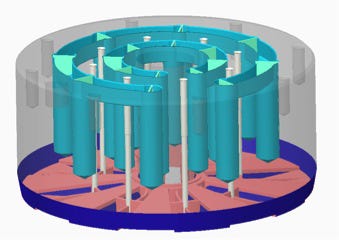
And here is the insert with a complex arrangement of conformal cooling channels with feed lines from the back of the insert.

The conventional and conformal inserts on the fixed half of the tool are shown below.
|
|
The difference in cooling channels between the two sets of inserts is striking, with the conformal design not even considered necessary, let alone deemed possible, in the first empirically designed set. However, component warpage was eliminated and the cycle time of the tool was reduced by 30% in this instance. The cost of the conformal inserts was quickly recovered, and similar results could be achieved with other injection mold tools.
This article was authored by Mike Godber, tool designer at New Zealand's largest toolmaker, RPM International Tool & Die. The company has particular expertise in the design and manufacture of conformal cooled mold tools. By integrating this technology into the whole tool design, RPM is able to provide customers with cost-effective, high-quality products. For more information on conformal cooling and direct metal laser sintering, go to the company website, www.rpmtoolanddie.com, or phone +64 9 479 8844.
About the Author(s)
You May Also Like
